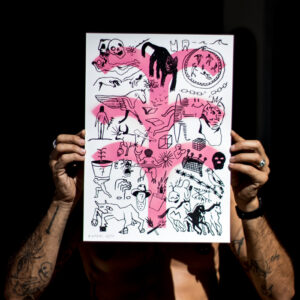ABOUT
BIOGRAPHY
Filippo Fiumani (b. 1987) is an Italian contemporary artist and actor based in Lisbon, Portugal. Working across sculpture, painting and installation, his multidisciplinary practice explores the friction between environmental decay, digital technology, human emotion, and urban chaos. Fiumani is known for creating bold, dynamic works that fuse abstract expressionism with figurative storytelling, layering vibrant colors, discarded materials, and symbolic fragments to build emotionally charged, socially engaged compositions.
Rooted in intuitive experimentation and informed by a background in street culture, his approach treats the city as both canvas and archive, transforming found objects, neon lights, microcomputers, and visual debris into kaleidoscopic narratives. His work navigates the complexity of contemporary identity, often juxtaposing joy and irony with vulnerability and disquiet. Through assemblage and sensory overload, Fiumani invites viewers into a raw and vital space of reflection, where beauty and entropy coexist.
Fiumani’s work has been exhibited in galleries and institutions across Europe, the United States and Canada.
FIUMANI´S ART STUDIO IS BASED IN LISBON (PT) , DROP HIM AN EMAIL!
instagram: @fiumani_
ARTIST STATEMENT
My practice is grounded in intuitive experimentation and a narrative impulse, emerging from a deep engagement with urban space and its residues. Rooted in formative experiences with skateboarding and graffiti, I first approached the city as a dynamic site of play, observation, and intervention. This early relationship to public space continues to inform my work, which explores the overlooked, the discarded, and the fragmentary as potent carriers of meaning.
Working across mixed media, I create installations, paintings, and screen-based pieces that incorporate found objects, neon LED, microcomputers, and technological debris. I’m drawn to the visual language of mass culture and consumerism, the things we throw away and the images we internalize without noticing. Through assemblage and recomposition, I build emotional and social landscapes that reflect on memory, cultural codes, and contemporary forms of disconnection. As part of this process, writing and language act as tools of assemblage, shaping the work from within. Words often surface alongside materials, leading me to dive into their roots, trace their etymologies and connections, and uncover new layers of meaning. Each piece becomes a tension point: between past and present, pop culture and critique, irony and vulnerability. In this friction between personal memory, language, and collective imagery, I aim to pose new questions, guided as much by intuition as by what I encounter in the world.
For me, art is a way to metabolize emotion. It helps me understand myself and, hopefully, offers something meaningful to others. I see creation as an act of resistance against conformity and speed, a way to reclaim attention and presence in a disposable, accelerated world.
Today, I understand my practice as a way of questioning life with enthusiasm: a vital force in constant transformation.


